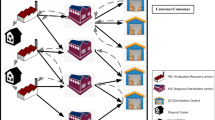Abstract
We consider the facility location problem for an expanding chain which competes with other chains offering the same goods or service in a geographical area. Customers are supposed to select the facility with maximum utility to be served and facilities in the expanding chain may have different owners. We first use the weighted method to develop an integer linear programming model to obtain Pareto optimal locations related to the inner competition between the owners of the old facilities and the owners of the new facilities. This model is applied to maximizing the profit of the expanding chain taking into account the loss in market share of its old facilities caused by the entering of new facilities (cannibalization effect). A study with data of Spanish municipalities shows that the cannibalization effect can be significantly reduced by sacrificing a small portion of profit.








Similar content being viewed by others
References
Berman, O., & Krass, D. (2002). Locating multiple competitive facilities: Spatial interaction models with variables expenditures. Annals of Operations Research, 11, 197–225.
Chandy, R. K., & Tellis, G. J. (1998). Organizing for radical product innovation: The overlooked role of willingness to cannibalize. Journal of Marketing Research, 35, 474–87.
Cohon, J. L. (1978). Multiobjective programming and planning. London: Academic Press.
Drezner, T. (1994). Optimal continuous location of a retail facility, facility attractiveness, and market share: An interactive model. Journal of Retailing, 70, 49–64.
Drezner, T., & Eiselt, H. A. (2002). Consumers in competitive location models. In Z. Drezner & H. Hamacher (Eds.), Facility Location: Application and Theory (pp. 151–178). Berlin: Springer.
Drezner, T., & Drezner, Z. (2004). Finding the optimal solution to the Huff based competitive location model. Computational Management Science, 1, 193–208.
Drezner, T. (2011). Cannibalization in a competitive environment. International Regional Science Review, 34, 306–322.
Fernández, J., Pelegrín, B., Plastria, F., & Tóth, B. (2007). Planar location and design of a new facilityy with inner and outer competition: An interval lexicographical-like solution procedure. Networks and Spatial Economics, 7, 19–44.
FICO Xpress Mosel (2009) Fair Isaac Corporation.
Francis, R. L., Lowe, T. J., & Tamir, A. (2002). Demand point aggregation for location models. In Z. Drezner & H. Hamacher (Eds.), Facility location: Application and theory (pp. 207–232). Berlin: Springer.
Friesz, T. L., Miller, T. C., & Tobin, R. L. (1988). Competitive network facility location models: A survey. Papers of the Regional science Association, 65, 47–57.
Ghosh, A., & Craig, C. S. (1991). FRANSYS: A franchise distribution system location model. Journal of Retailing, 67, 466–495.
Hakimi, S. L. (1990). Locations with spatial interactions: Competitive locations and games. In R. L. Francis & P. B. Mirchandani (Eds.), Discrete location theory. London: Wiley.
Huff, D. L. (1964). Defining and estimating a trading area. Journal of Marketing, 28, 34–38.
Louveaux, F., Thisse, J. F., & Beguin, H. (1982). Location theory and transportation costs. Regional Science and Urban Economics, 12, 529–545.
Mazumdar, T., Sivakumar, K., & Wilemon, D. (1996). Launching new products with cannibalization potential: An optimal timing framework. Journal of Marketing Theory and Practice, 4, 83–94.
Nakanishi, M., & Cooper, L. G. (1974). Parameter estimate for mutiplicative interactive choice model: Least square approach. Journal of Marketing Research, 11, 303–311.
Peeters, P. H., & Plastria, F. (1998). Discretization results for the Huff and Pareto-Huff competitive location models on networks. TOP, 2, 247–260.
Pelegrín, B., Fernández, P., García, M. D., & Cano, S. (2012). On the location of new facilities for chain expansion under delivered pricing. Omega, 40, 149–158.
Pirkul, H., Narasimhan, S., & De, P. (1987). Firm expansion through franchising: A model and solution procedures. Decision Sciences, 18, 631–645.
Plastria, F. (2001). Static competitive facility location: An overview of optimisation approaches. European Journal of Operational Research, 129, 461–470.
Plastria, F. (2005). Avoiding cannibalization and/or competitor reaction in planar single facility location. Journal of Operations Research of Japan, 48, 148–157.
Revelle, C. S., & Eiselt, H. A. (2005). Location analysis: A synthesis and a survey. European Journal of Operational Research, 165, 1–19.
Serra, D., & Colomé, R. (2001). Consumer choice and optimal locations model: Formulations and heuristics. Papers in Regional Science, 80, 439–464.
Suárez-Vega, R., Santos-Peñate, D. R., & Dorta-González, P. (2004). Competitive multifacility location on networks: The (r/Xp)-medianoid problem. Journal of Regional Science, 44, 569–588.
Suárez-Vega, R., Santos-Peñate, D. R., & Dorta-González, P. (2007). The follower location problem with attraction thresholds. Papers in Regional Science, 86, 123–137.
Suárez-Vega, R., Santos-Peñate, D. R., & Dorta-González, P. (2011). Location models and GIS tools for retail site location. Applied Geography, 35, 12–22.
Suárez-Vega, R., & Santos-Peñate, D. R. (2014). The use of GIS tools to support decision-making in the expansion of chain stores. International Journal of Geographical Information, 28, 553–569.
Acknowledgments
This research has been supported by the Ministry of Science and Technology of Spain under the research project ECO2011-24927, in part financed by the European Regional Development Fund (ERDF).
Author information
Authors and Affiliations
Corresponding author
Rights and permissions
About this article
Cite this article
Pelegrín, B., Fernández, P. & García Pérez, M.D. Profit maximization and reduction of the cannibalization effect in chain expansion. Ann Oper Res 246, 57–75 (2016). https://doi.org/10.1007/s10479-014-1676-5
Published:
Issue Date:
DOI: https://doi.org/10.1007/s10479-014-1676-5



